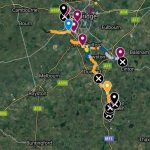
Click here for Balsam Related Resources
Himalayan Balsam (‘Policeman’s Helmet’, ‘Touch-me-not’, ‘Jumping Jack’) is an extremely invasive non-native annual plant. Introduced in the 19th Century as a garden plant because of its imposing stature and attractive flowers, it quickly spread into the wild and is common in the UK. It is spreading along the Cam and Granta and their tributaries and in recent years dense stands of plants up to 3m high have established on some stretches. It grows well in moist and semi-shaded damp places, predominantly on the soft banksides of slow-moving watercourses. Where it becomes dominant it reduces biodiversity, can choke waterways leading to flooding and competes with native flowers for pollinating insects–especially bees. Frosts kill the plants and in winter the ground is left bare and thus vulnerable to erosion leading to bank loss and unwanted sediment in the water.
Balsam seedlings emerge from March, pinkish flowers develop from late June until late September, and seed pods mature from August. Each plant produces up to 800 seeds which are shed up to 7 metres away. Patches become self-seeding, and seeds can be carried long distances downstream.
Himalayan Balsam is now listed under schedule 9 of the Wildlife and Countryside Act (1981) and it is an offence to plant it in the wild or otherwise cause it to grow in the wild.
How volunteers can help
Conservation-minded organisations including the Environment Agency are often involved in removing it. Volunteers have an important role.
Surveying: Summer and early autumn are good times to look for flowering Balsam and report it to us. Do attach photo if you are unsure of the identity and give us an idea of its abundance over a 100m stretch of bank. Are there: a) 1–5 individual plants, b) scattered patches each up to one metre wide, or c) frequent patches with some 5 m wide or more. Many stretches have been checked already but we welcome all sightings on the Cam and lodes between Clayhithe and Ely; the Cam (Essex) from Newport to Widdington; Fulfen Slade and Debden Water; also the Rhee between Ashwell and Wimpole; and the Granta between Hildersham and Bartlow. Please email sightings to Mike Foley mfpfoley@gmail.com
Removal: In 2020, CVF will join the Wildlife Trust BCN and the Cambridge Conservation Volunteers in their ongoing efforts to eradicate it from Bourn Brook, and will help Cambridge City Rangers make the city a Balsam-free zone. We will also be working alongside Essex Wildlife Trust in the Saffron Walden area and will be organising various CVF Balsam Bashing working parties in the Cambridge area.
If you would like to help or want more information, please register here or email Mike Foley mfpfoley@gmail.com
Status Maps of Himalayan Balsam on the Cam with a downloadable detailed Survey of Himalayan Balsam in the Cam Catchment 2019
Downloadable advice sheet from Cam Valley Forum on how to identify and remove Himalayan Balsam: Balsam Advisory sheet
NNSS Balsam description and identification
Primary CVF contact for Balsam sightings and queries: please email Mike Foley mfpfoley@gmail.com

